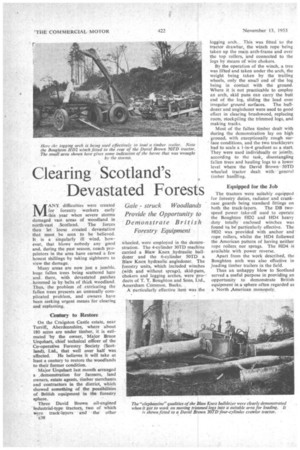Clearing Scotland's Devastated Forests
Page 144

If you've noticed an error in this article please click here to report it so we can fix it.
Gale struck Woodlands Provide the Opportunity to Demonstrate British Forestry Equipment
MANY difficulties were created for forestry workers early this year when severe storms damaged vast areas of woodland in north-east Scotland. The forces then let loose created • devastation that must be seen to be believed. It is a singularly ill wind, however, that blows nobody any good and, during the past season, coach proprietors in the area have earned a few honest shillings by taking sightseers to view the damage.
Many areas are now just a jumble, huge fallen trees being scattered here and there, with devastated patches hemmed in by belts of thick woodland. Thus, the problem of extricating the fallen trees presents an unusually complicated problem, and owners have been seeking urgent means for clearing and replanting.
Century to Restore
On the Craigston Castle estate, near Turriff, Aberdeenshire, where about 180 acres are under timber, it is estimated by the owner, Major Bruce Urquhart, chief technical officer of the Co-operative Forestry Society (Scotland), Ltd., that well over half was affected. He believes it will take at least a century to restore the woodlands to their former condition.
Major Urquhart last month arranged a .demonstration for farmers, land owners, estate agents, timber merchants and contractors in the district, which showed something of the possibilities of British equipment in the forestry sphere.
Three David Brown oil-engined industrial-type tractors, two of which were track-layers and the other 1.:38 wheeled, were employed in the demonstration. The 4-cylinder 30TD machine carried a Blaw Knox hydraulic bulldozer and the 6-cylinder 50TD a Blaw Knox hydraulic angledozer. The forestry units, which included winches (with and without sprags), skid-pans, chokers and logging arches, were products of T. T. Boughton and Sons, Ltd., Amersham Common. Bucks.
A particularly effective item was the logging arch. This was fitted to the tractor drawbar, the winch rope being taken up the main arch-frame and over the top rollers, and connected to the logs by means of wire chokers.
By the operation of the winch, a tree was lifted and taken under the arch, the weight being taken by the trailing wheels, only the small end of the log being in contact with the ground. Where it is not practicable to employ an arch, skid pans can carry the butt end of the log, sliding the load over
irregular ground surfaces. The bulldozer and angledozer were used to good effect in clearing brushwood, replacing roots; stockpiling the trimmed logs, and making tracks.
Most of the fallen timber dealt with during the demonstration lay on high ground, with exceptionally rough surface conditions, and the two tracklayers had to scale a 1-in-4 gradient as a start. They were used individually or jointly, according to the task, disentangling fallen trees and hauling logs to a lower level where the David Brown ••50TD wheeled tractor dealt with general timber hanal i ng.
Equipped for the Job The tractors were suitably equipped for forestry duties, radiator and crankcase guards being standard fittings on both the track-layers. The DB twospeed power take-off used to operate the Boughton HD2 and HD4 heavy duty totally enclosed winches was found to be particularly effective. The HD2 was provided with anchor and rope rollers, whilst the HD4 followed the American pattern of having neither rope rollers nor sprags. The HD4 it available with power reverse.
Apart from the work described, the Boughton arch was also effective in loading timber trailers in the field.
Thus an unhappy blow to Scotland served a useful purpose in providing an opportunity to demonstrate British equipment in a sphere often regarded as a North American monopoly.












































































































































































































































